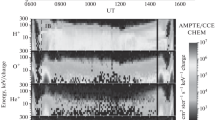Abstract
Results are presented of two instrumented rocket experiments performed from an equatorial station, one at night and the other shortly after sunrise. The ion neutral composition as well as electron density and the amplitude of plasma irregularities were monitored. During the latter flight, a sharp layer of ionisation with its lower boundary at 100 km was observed. The layer had a half width close to 1 km and a peak electron density of 5·6× 104cm−3. Large amplitude of plasma irregularities, noticed on the negative gradient portion of the layer indicates a downward direction of the polarisation electric field during the observations. The resulting downward drift of photoions as they are produced at sunrise followed by the local decrease of the drift is suggested to be the cause of the layer formation at that altitude. The long lasting nature of such layers once identified on ionograms indicates that they are constituted of metallic ions possibly of micrometeoritic origin deposited overnight in the lower thermosphere. The required photoionisation rate of production of the metallic ions at sunris eis about 2 cm−3 sec−1.
Similar content being viewed by others
References
Aikin A C and Goldberg R A 1973J. Geophys. Res. 78 734
Ananda Rao, Raghavendra Rao B R and Reddy C R 1977J. Geophys. Res. 82 1510
Anderson J G and Barth C A 1971J Geophys. Res. 76 3723
Balsley B B and Woodman R F 1969J. Atmos. Terr. Phys. 31 865
Danilov A D, Pokhunkov A A, Semenov V K, Vorfolomeev V A, Shirke J S, Sridharan ReGupta S P and Pradhan S N 1980Adv. Space Exploration Vol. 7 Low latitude Aeronomi, Processes P. 111
Hawkins G S 1956Mon. Not. R. Astron. Soc. 116 103
Istomin V G 1963Space Res. 3 209
Johannessen A and Krankowsky D 1972J. Geophys. Res. 77 2888
Lebedinets V N and Shushkova V B 1970Planet. Space Sci. 18 1653, 1659
Narcisi R S and Bailey A D 1965J. Geophys. Res. 70 3687
Narcisi R S 1968Space Res. 8 360
Prakash S and Pandey R 1979Proc. Indian Acad. Sci. (Earth Planet. Sci.) 88 229
Reid G C 1968J. Geophys. Res. 73 1627
Satya Prakash, Gupta S P and Subbaraya B H 1969Rad. Sci. 4 791
Satya Prakash and Subbaraya B H 1967Rev. Sci. Instrum. 38 1132
Shirke J S and Sridharan R 1967Proc. Indian Acad. Sci. (Earth Planet. Sci.) 88 219
Swider W Jr 1909Planet. Space Sci. 17 1233
Woodman R F 1979J. Geophys. Res. 75 6249
Young J M, Johnson C Y and Holmes J C 1967J. Geophys. Res. 72 1473
Zbinden P A, Hidalgo M A, Eberhardt P and Geiss J 1975Planet. Space Sci. 23 1621
Author information
Authors and Affiliations
Additional information
deceased
Rights and permissions
About this article
Cite this article
Shirke, J.S., Sridharan, R., Gupta, S.P. et al. On the formation of a sharp layer of metallic constituents at sunrise in the lower thermosphere. Proc. Indian Acad. Sci. (Earth Planet Sci.) 90, 141–146 (1981). https://doi.org/10.1007/BF02880258
Received:
Revised:
Issue Date:
DOI: https://doi.org/10.1007/BF02880258




